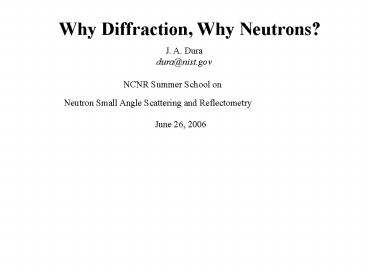Why Diffraction, Why Neutrons? PowerPoint PPT Presentation
Title: Why Diffraction, Why Neutrons?
1
Why Diffraction, Why Neutrons?
J. A. Dura dura_at_nist.gov
NCNR Summer School on
Neutron Small Angle Scattering and Reflectometry
June 26, 2006
2
Why Diffraction?
3 choices for microscopic structural information
Examples Advantages Disadvantages
Microscopy Optical TEM Field Ion Direct Local information
Scanning Probes AFM STM SEM Direct Local information Surfaces only
Diffraction Probes Electron (RHEED, LEED) X-ray Neutron Quantitative data on correlations and distribution of structural features Probes entire sample Requires Fitting
3
Neutron Energy, Momentum, and Wavelength
4
Scattering Events and Reciprocal Space
5
Destructive Interference
- ImI0 S( ,w)
- Depends only on sample/independent of instrument
- Each point in reciprocal space derived from
entire sample - Representative sampling of whole Reciprocal space
needed - to fully recreate sample
Constructive Interference
6
Why Neutrons? The properties of the neutron lead
to unique experimental techniques with
particular advantages
Neutron Interactions and Dosimetry Group /
Physics Laboratory
- Subatomic Particle
- Particle Related Physics
- Nuclear Activation
- PGAA, NDP, Radiography
- Energies excitations in materials
- Inelastic Scattering
Studies the weak interactions of the neutron Neutron decay lifetime, Decay angular correlations, Low energy neutron-nucleon interactions Consequences for Cosmology, Weak interactions physics Tests of the Standard Model of Particle physics
PGAA
NDP
Cold Neutron Trap
7
Elastic vs. Inelastic Scattering
Probes dynamics energy transferred from
excitations in the sample
Probes structures by interference of neutrons
scattered from them
8
(No Transcript)
9
Why Neutrons? The properties of the neutron lead
to unique experimental techniques with
particular advantages
- Spin 1/2 Particle
- magnetic sensitivity
- Neutral Particle - Interacts with
- Nucleus via Strong Force
- light element sensitivity (independent of Z)
- isotope effect
- isotropic scattering (no form factor)
- Subatomic Particle
- Particle Related Physics
- Nuclear Activation
- PGAA, NDP, Radiography
- Energies excitations in materials
- Inelastic Scattering
- Wavelength atomic spacing lower limit on sizes
- Geometry of the motions
- Interferometry
- Elastic Scattering Techniques
- (SANS, NR, Diffraction)
Nuclear
Magnetic
10
Why Neutrons? The properties of the neutron lead
to unique experimental techniques with
particular advantages
- Spin 1/2 Particle
- magnetic sensitivity
- Neutral Particle - Interacts with
- Nucleus via Strong Force
- light element sensitivity (independent of Z)
- isotope effect
- isotropic scattering (no form factor)
- Neutral Particle Weakly interacting
- penetrating
- Simplified scattering theory
- Non-destructive
- Simplified sample environments
- Penetrates the whole sample
- Imaging
- Residual Stress Analysis
- Probes the entire sample simultaneously
- Statistics on sample wide distributions of
features
- Subatomic Particle
- Particle Related Physics
- Nuclear Activation
- PGAA, NDP, Radiography
- Energies excitations in materials
- Inelastic Scattering
- Wavelength atomic spacing lower limit on sizes
- Geometry of the motions
- Interferometry
- Elastic Scattering Techniques
- (SANS, NR, Diffraction)
11
(No Transcript)

